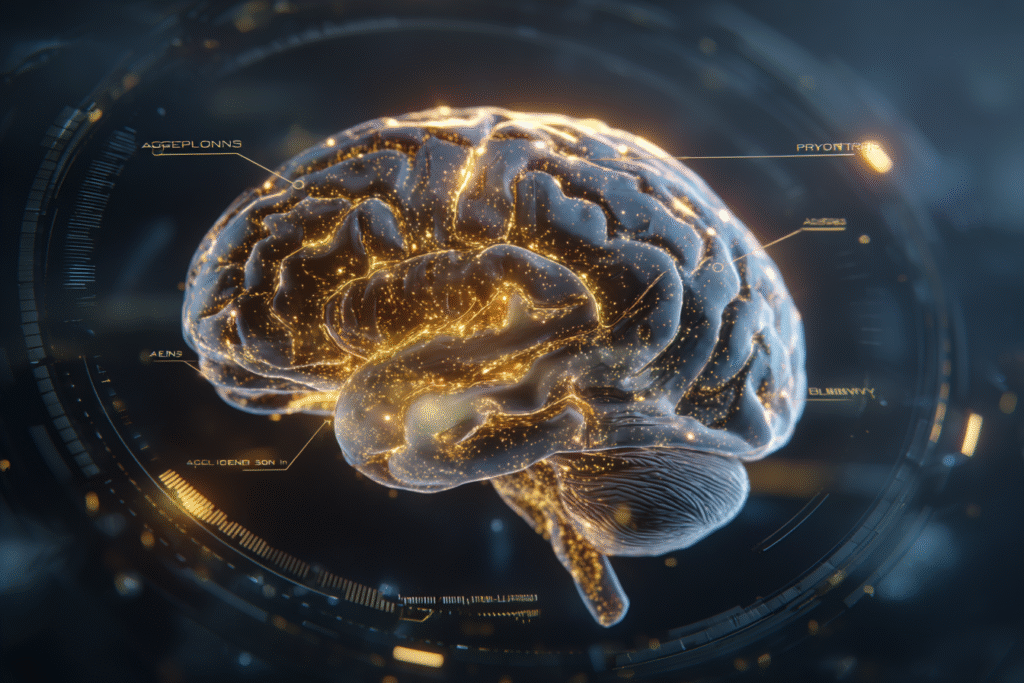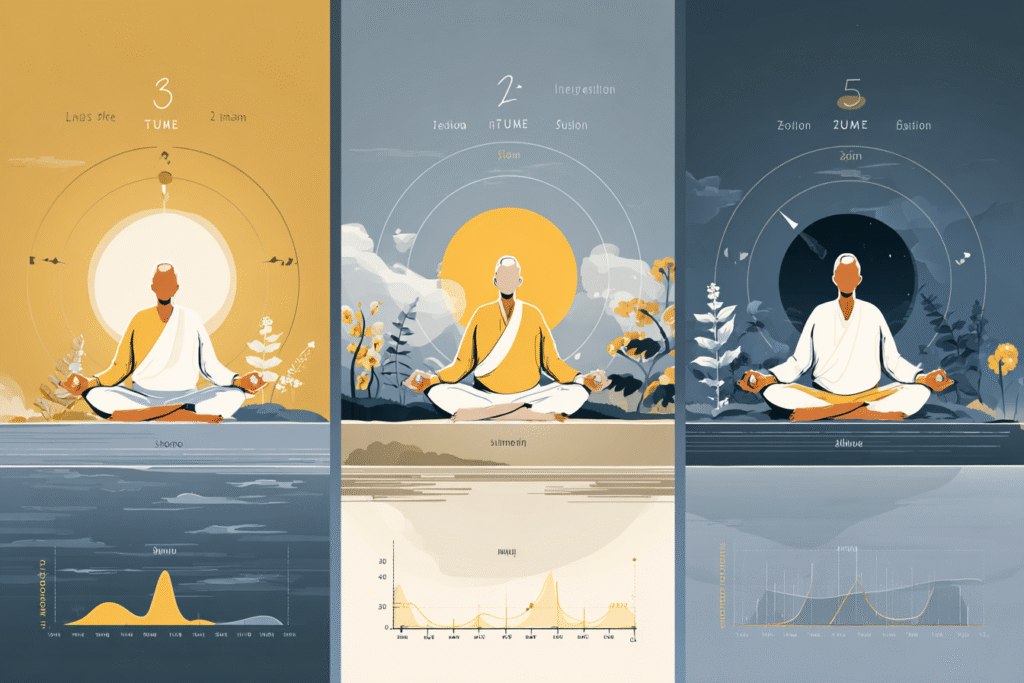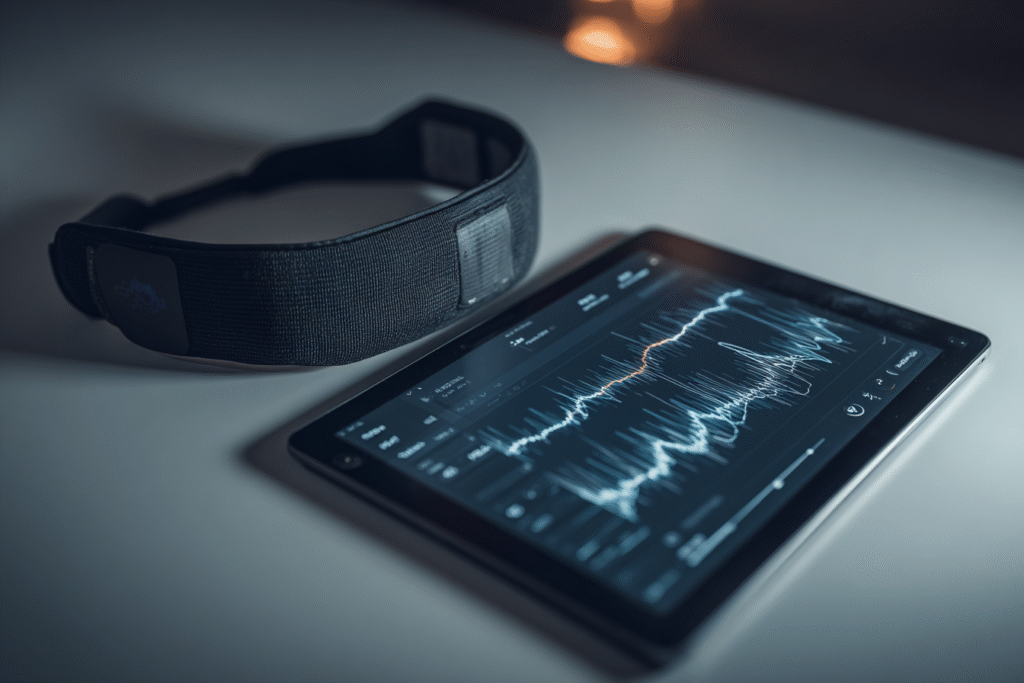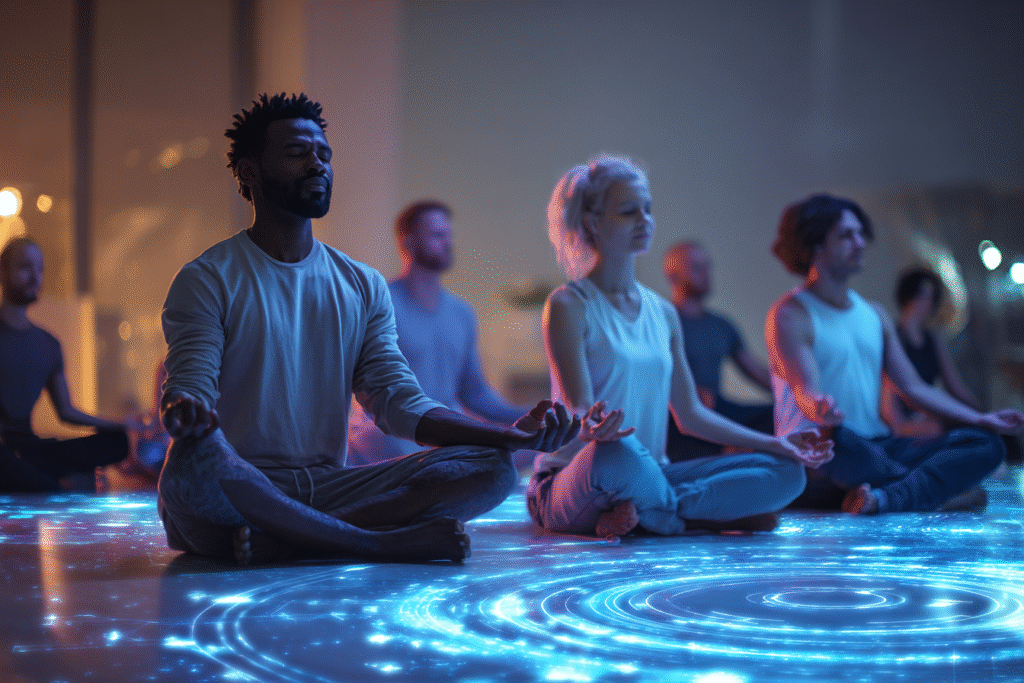You don’t need high-tech equipment to access the most advanced health system ever created—it’s already installed in your skull.
Note: This article is for educational and informational purposes only. See full disclaimer at the end.
The moment you close your eyes and begin to focus on your breath, you’re activating a biological system so advanced that decades of scientific research are only beginning to understand its full potential. While we chase the latest wearables and health apps, meditation quietly operates as the ultimate health technology—one that rewires your brain, optimizes your immune system, and transforms your relationship with stress and disease.
Despite extensive scientific backing for meditation’s benefits, skepticism persists. Many people still view meditation as mystical or esoteric, thinking it requires emptying the mind completely or achieving some otherworldly state. Others expect instant results, not realizing that meditation’s most profound benefits emerge through consistent practice that gradually rewires the neural pathways responsible for stress, anxiety, and physical health.
The reality is far more practical and achievable. Meditation is health technology in the truest sense—a systematic approach to optimizing your body’s biological functions through targeted mental training. Modern neuroscience has revealed exactly how this ancient practice creates measurable changes in brain structure, immune function, and overall health outcomes.

The Science of Meditation as Medicine
Brain Restructuring Through Practice
Harvard neuroscientist Sara Lazar and her team were the first to demonstrate that meditation literally changes brain structure [1]. MRI scans revealed that just eight weeks of mindfulness meditation increased gray matter density in the hippocampus (crucial for learning and memory) and areas associated with self-awareness, compassion, and introspection [1].
Participants who meditated an average of 27 minutes daily showed decreased gray matter density in the amygdala—the brain’s alarm center responsible for anxiety and stress responses [1]. As Britta Hölzel, the study’s lead author, explains: “It is fascinating to see the brain’s plasticity and that, by practicing meditation, we can play an active role in changing the brain and can increase our well-being and quality of life” [1].
Physiological Health Transformations
Beyond brain changes, meditation creates measurable improvements across multiple biological systems. A comprehensive 2023 review in the journal Cureus documented meditation’s effects on immune function, genetics, and aging processes [2]:
- Immune System Enhancement: Decreases inflammatory cytokines and increases immune responsiveness
- Healthy Aging: Appropriate telomerase regulation helps maintain cellular longevity
- Cardiovascular Benefits: Reduced blood pressure, lower cholesterol, increased HDL levels
- Multi-system Impact: Improvements in diabetes management, hypertension control, and fibromyalgia symptoms
The National Center for Complementary and Integrative Health confirms that meditation shows moderate but consistent effects for depression, chronic pain, and anxiety—comparable to established treatments [3].
The Stress-Disease Connection
Meditation’s health benefits stem largely from its ability to interrupt the stress-disease cycle. Harvard researchers studying depression found that meditation changes brain activation patterns even when individuals are not actively meditating [4]. This suggests that regular practice creates lasting changes in how the brain processes stress and emotional regulation.
A 2017 review of 45 studies demonstrated that various forms of meditation significantly decrease physiological stress markers, including cortisol levels and heart rate [5]. These changes directly reduce risk for stress-related conditions like IBS, PTSD, and fibromyalgia.

Making Meditation Systematic
Starting with Minimal Effective Dose
The beauty of meditation as health technology lies in its accessibility. Research shows benefits beginning with remarkably small time investments:
- 13 minutes daily enhanced attention and memory after 8 weeks [5]
- 20 minutes daily produced significant stress reduction in healthcare workers during COVID-19 [6]
- 27 minutes daily (the Harvard study average) created measurable brain structural changes [1]
The key insight? Consistency matters more than duration. Daily practice creates cumulative neuroplastic changes that compound over time.
The Three-Phase Integration Approach
Based on the scientific literature and practical implementation research, here’s a systematic approach to meditation as health technology:
Phase 1: Foundation Building (Weeks 1-4)
- Start with 5-10 minutes of basic breath awareness daily
- Same time each day to establish neural habit pathways
- Focus on simply noticing when attention wanders and gently returning to breath
- Track only consistency—not subjective notions of “how well” you did
Once daily practice feels consistent and automatic, you’re ready to deepen the experience in Phase 2.
Phase 2: Deepening Practice (Weeks 5-8)
- Extend sessions to 15-20 minutes
- Introduce body scan techniques for enhanced interoception
- Begin observing thoughts and emotions without judgment
- Notice stress responses throughout the day and apply breath awareness
Once you begin noticing shifts in your emotional and stress responses, it’s time to expand the practice into daily life through Phase 3.
Phase 3: Health Technology Integration (Weeks 9+)
- Use meditation as targeted intervention for specific health goals
- Apply mindfulness during medical appointments and health decisions
- Integrate brief mindfulness moments during stressful situations
- Combine with other health technologies for enhanced effectiveness
With meditation now embedded in your routine, you can begin using it as a precision tool for specific health goals and real-time stress modulation.

Technology-Enhanced Meditation
Modern neurofeedback devices are revolutionizing meditation practice by providing real-time brain state feedback. EEG-based meditation headbands like Muse, FocusCalm, and BrainBit use electroencephalography (EEG) to measure brain waves and provide audio feedback during meditation [7].
These devices track different brainwave states:
- Alpha waves (8-13.9 Hz): Relaxed, meditative states
- Theta waves (4-7.9 Hz): Deep meditation and REM sleep patterns
- Beta waves (14-30 Hz): Alert, engaged consciousness
Research shows neurofeedback apps significantly reduce perceived stress across diverse populations [6]. The real-time feedback helps users recognize and reinforce target brain states, accelerating the learning process.
Addressing Common Misconceptions
“I Can’t Empty My Mind”
The biggest barrier to meditation practice stems from misunderstanding its purpose. Meditation isn’t about stopping thoughts—it’s about changing your relationship with thoughts. Neuroscience research shows that each time you notice your mind has wandered—and gently return to the breath—you’re strengthening attention networks in the brain [8].
Dr. Sara Lazar’s research demonstrates that individuals who meditate regularly show higher activation in attention networks compared to non-meditators [8]. The “wandering mind” isn’t failure—it’s the training material that strengthens attention.
“I Don’t Have Time”
This objection dissolves when meditation is reframed as health technology rather than luxury. Given that meditation produces effects comparable to medication for anxiety and depression while strengthening immune function and cardiovascular health, the real question is: can you afford not to meditate?
A practicing GP in Wales prescribes meditation to patients with chronic pain, writing out “prescriptions for six weeks of daily meditations” [9]. He reports significant pain reduction and decreased need for analgesic medications. His insight: “Meditation can be done anywhere, and does not need special equipment. It is the one health measure that is not dependent on money” [9].
“The Benefits Aren’t Instant”
This expectation reflects a misunderstanding of how biological systems adapt. Just as cardiovascular fitness develops through consistent training, neural fitness develops through consistent meditation practice. The Harvard studies show measurable brain changes within 8 weeks, but the process is gradual and cumulative [1].
Research indicates that meditation benefits compound over time [10]. Practitioners report that stress reactivity decreases, emotional regulation improves, and baseline well-being increases as neuroplastic changes accumulate.

Building Your Meditation Health System
Daily Integration Strategies
The most successful meditation practitioners treat it as essential health infrastructure, not optional wellness activity. Consider these integration strategies:
Morning Activation Protocol
- 10-15 minutes upon waking to set nervous system tone for the day
- Combined with other morning health practices (exercise, nutrition)
- Use meditation to enhance awareness of how diet and movement affect you
Stress Response Interruption
- Brief 3-5 minute practices during high-stress periods
- Breath awareness during medical appointments to enhance communication
- Mindful transitions between work activities to prevent stress accumulation
Evening Recovery Protocol
- 15-20 minutes before sleep to activate parasympathetic recovery
- Body scan meditation to identify and release physical tension
- Gratitude practice to shift focus from daily stresses to positive experiences
Tracking Health Technology Metrics
Like any high-impact health strategy, meditation improves with feedback. Tracking amplifies awareness—and results.
Subjective Measures
- Stress levels (1-10 scale) before and after sessions
- Sleep quality and duration
- Energy levels throughout the day
- Emotional stability during challenging situations
Objective Measures (if available)
- Heart rate variability improvement
- Blood pressure trends over time
- Resting heart rate changes
- Sleep architecture via wearable devices
Behavioral Measures
- Consistency of daily practice
- Ability to maintain attention during sessions
- Speed of stress recovery after difficult events
- Overall life satisfaction and well-being scores

The Ripple Effects of Daily Practice
Enhanced Health Decision-Making
Regular meditation practice improves interoception—awareness of internal bodily signals [11]. This enhanced body awareness translates into better health decisions—recognizing hunger vs. stress eating, noticing fatigue before burnout, identifying early signs of illness.
Harvard researcher Gaëlle Desbordes studies how meditation training “boosts body awareness in the moment, called interoception, which, by focusing their attention on the here and now, arms participants to break the cycle of self-rumination” [4].
Improved Medical Outcomes
Studies show that patients who practice meditation demonstrate better treatment adherence, improved communication with healthcare providers, and reduced medical costs [12]. The enhanced awareness and emotional regulation developed through practice translates into more effective healthcare utilization.
Systemic Health Optimization
Most importantly, meditation as health technology creates positive feedback loops throughout your health system. Reduced stress improves sleep quality, which enhances immune function, which supports better stress management, which sharpens decision-making, reinforcing healthier lifestyle choices.
This is why meditation practitioners often report that their overall health improves beyond what the practice directly addresses. By optimizing the nervous system’s baseline functioning, meditation creates conditions for enhanced health across all domains.

Your 30-Day Meditation Technology Pilot
Based on the research evidence and practical implementation strategies, here’s a systematic approach to testing meditation as health technology in your own life:
Week 1-2: Baseline and Basic Installation
- Day 1-3: Establish baseline measurements (stress levels, sleep quality, energy)
- Day 4-14: 10 minutes daily breath awareness meditation, same time each day
- Track: Only one thing: Did you practice today?
- Goal: Build neural habit pathways through repetition
Week 3-4: System Optimization
- Day 15-28: Extend to 15 minutes daily
- Add: Brief 3-minute stress response practices during challenging moments
- Track: Subjective stress levels before/after sessions
- Goal: Begin noticing meditation’s effects on daily stress reactivity
Week 5+: Health Technology Integration
- Maintain: 15-20 minutes daily foundational practice
- Expand: Apply mindfulness during health-related activities
- Monitor: Sleep quality, emotional regulation, physical tension patterns
- Goal: Integrate meditation as core health infrastructure
Technology Enhancement Options
If interested in neurofeedback-enhanced practice:
The Future of Meditation as Health Technology
As neuroscience continues revealing meditation’s mechanisms, we’re moving toward increasingly sophisticated integration with health technology. Recent research on extracellular vesicles suggests meditation influences cellular communication pathways that affect disease onset and progression [15].
The MindGAP research project identified seven specific microRNAs that change with meditation practice, potentially providing biomarkers for meditation’s health effects [15]. We may soon personalize meditation using molecular feedback and biometric signals.
As AI and wearable technology advance, we’re approaching personalized meditation prescriptions based on individual health profiles, stress patterns, and biological markers. This ancient practice may soon become the foundation for 21st-century preventive medicine.

Beyond Individual Practice
The implications extend beyond individual health improvement. When meditation is implemented systematically in healthcare settings, schools, and workplaces, it creates population-level health benefits [9].
Healthcare systems are beginning to recognize meditation as cost-effective preventive medicine. The Welsh GP prescribing meditation reports: “From a personal point of view, regular meditation means I no longer feel like a stressed-out GP. I can be totally present in my consultations, and I genuinely enjoy working” [9].
As the research evidence grows stronger and implementation becomes more systematic, meditation is transitioning from alternative therapy to mainstream health technology. The skepticism will continue to fade as the science becomes undeniable and the practical benefits become impossible to ignore.
The most powerful health technology you’ll ever use has no side effects, needs no prescription, and only grows stronger with use. It’s time to take meditation seriously as health technology—not because it’s trendy, but because the science demands it.
See you in the next insight.
Comprehensive Medical Disclaimer: The insights, frameworks, and recommendations shared in this article are for educational and informational purposes only. They represent a synthesis of research, technology applications, and personal optimization strategies, not medical advice. Individual health needs vary significantly, and what works for one person may not be appropriate for another. Always consult with qualified healthcare professionals before making any significant changes to your lifestyle, nutrition, exercise routine, supplement regimen, or medical treatments. This content does not replace professional medical diagnosis, treatment, or care. If you have specific health concerns or conditions, seek guidance from licensed healthcare practitioners familiar with your individual circumstances.
References
The references below are organized by study type. Peer-reviewed research provides the primary evidence base, while systematic reviews synthesize findings across multiple studies for broader perspective.
Peer-Reviewed / Academic Sources
- [1] Hölzel, B.K., et al. (2011). Eight weeks to a better brain: Meditation study shows changes associated with awareness, stress. Harvard Gazette. https://news.harvard.edu/gazette/story/2011/01/eight-weeks-to-a-better-brain/
- [2] Jamil, A., Gutlapalli, S.D., Ali, M., Oble, M.J.P., Sonia, S.N., George, S., Shahi, S.R., Ali, Z., Abaza, A., & Mohammed, L. (2023). Meditation and Its Mental and Physical Health Benefits in 2023. Cureus. https://www.ncbi.nlm.nih.gov/pmc/articles/PMC10355843/
- [3] National Center for Complementary and Integrative Health. (2024). Meditation and Mindfulness: Effectiveness and Safety. NIH/NCCIH. https://www.nccih.nih.gov/health/meditation-and-mindfulness-effectiveness-and-safety
- [4] Desbordes, G., & Shapero, B. (2018). Harvard researchers study how mindfulness may change the brain in depressed patients. Harvard Gazette. https://news.harvard.edu/gazette/story/2018/04/harvard-researchers-study-how-mindfulness-may-change-the-brain-in-depressed-patients/
- [5] Thorpe, M. & Ajmera, R. (2023). 12 Science-Based Benefits of Meditation. Healthline. https://www.healthline.com/nutrition/12-benefits-of-meditation
- [6] Pascoe, M.C., et al. (2023). The Impact of Mindful Meditation on Health Care Workers During the COVID-19 Pandemic. PMC. https://pmc.ncbi.nlm.nih.gov/articles/PMC9894608/
- [7] DIY Genius. (2024). Hack Your Brain Waves With Wearable Meditation Headsets. https://www.diygenius.com/hacking-your-brain-waves/
- [8] Bhattacharjee, Y. (2024). Does meditation actually work? Here’s what the science says. National Geographic. https://www.nationalgeographic.com/premium/article/meditation-decrease-stress-health
- [9] British Association for Holistic Medicine. (2023). Measurable beneficial effects: the evidence for using meditation in everyday healthcare. https://bhma.org/measurable-beneficial-effects-the-evidence-for-using-meditation-in-everyday-healthcare/
- [10] ScienceDirect. (2021). Psychobiological mechanisms underlying the mood benefits of meditation: A narrative review. https://www.sciencedirect.com/science/article/pii/S2666497621000114
- [11] Lazar Lab for Meditation Research. (2024). Massachusetts General Hospital. https://www.massgeneral.org/psychiatry/research/lazar-lab-for-meditation-research
- [12] UC Davis Health. (2022). 10 health benefits of meditation and how to focus on mindfulness. https://health.ucdavis.edu/blog/cultivating-health/10-health-benefits-of-meditation-and-how-to-focus-on-mindfulness-and-compassion/2022/12
Industry / Technology Sources
- [13] Muse. (2024). Muse: the brain sensing headband. https://choosemuse.com/
- [14] FocusCalm. (2024). Biofeedback Device, EEG Headband, Brain Training. https://focuscalm.com/products/focuscalm-eeg-headband
- [15] European Commission. (2024). Mindful molecules – science is decoding the health benefits of meditation. Horizon Magazine. https://projects.research-and-innovation.ec.europa.eu/en/horizon-magazine/mindful-molecules-science-decoding-health-benefits-meditation


